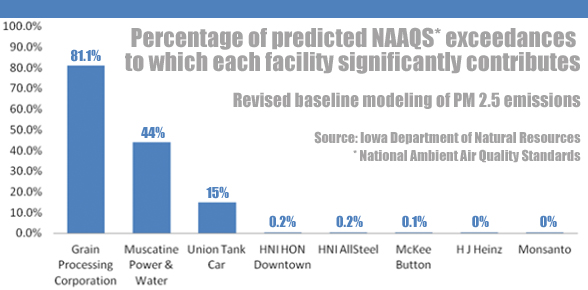Iowa Capital Dispatch
December 11, 2025
A federal judge has ruled federal animal-welfare inspectors can no longer conduct “courtesy visits” at dog-breeding operations while allowing violations to go unreported.
The ruling could... more
The Iowa Department of Natural Resources (IDNR) is taking a second shot at getting federal approval for a plan to reduce fine particulate (PM2.5) pollution in Muscatine.
The IDNR's first submission of a State Implementation Plan (SIP) to cut emissions of particulate matter less than 2.5 microns in diameter was found "substantially inadequate to maintain the 2006 24-hour National Air Quality Standard (NAAQS) for PM2.5 in Muscatine." That finding in July 2011 by the U.S. Environmental Protection Agency Region 7 office required the IDNR to conduct air modeling to determine what facilities in the area were signficantly contributing to exceedances of the air quality standards.
"The Iowa DNR determined that three major sources of air pollution in the Muscatine area significantly contribute to predicted (modeled) PM2.5 exceedances of the standard in the vicinity of the Garfield School monitor," according to the new proposed SIP plant. "These facilities are Grain Processing Corporation (GPC), Muscatine Power & Water, and Union Tank Car Company."
According to the new SIP draft, the IDNR has worked with the three companies on measures "that will result in expeditious attainment of the 24-hour PM2.5 NAAQS through reductions of ambient air impacts of PM2.5 emissions from each facility."

The reductions in PM2.5 emissions would come from installation of new particulate controls or improvements to existing particulate controls; retirement of some existing equipment; replacement of existing operations with new, more efficient equipment; regular sweeping and watering of road surfaces; increasing emission stack heights; and restricting operation of certain processes.
The IDNR estimates the changes will reduce PM2.5 emissions nearly 370 tons per year from the three combined companies, with nearly all of that reduction (368 tons per year) coming from lower emissions from GPC.
The control measures at Muscatine Power and Union Tank will be implemented during 2013, according to the SIP draft, but "due to the scale and complexity of the changes at GPC, GPC has developed a phased implementation schedule that begins in 2013 and concludes in December 2016."
GPC currently emits 537.6 tons of fine particulate each year and that would be lowered more than 68 percent under the proposed plans. Muscatine Power emissions of PM2.5 at its coal-fired power plant are currently 58.3 tons per year and Union Tank's facility currently emits 3 tons of PM2.5 per year.
A public hearing on the SIP will be held June 24 at 2 p.m. in the Muscatine City Hall Council Chambers, 215 Sycamore St., Muscatine. Comments also can be submitted directly to the Iowa DNR until 4:30 p.m., June 25. The written comments should be directed to Jim McGraw, Department of Natural Resources, Air Quality Bureau, 7900 Hickman Road, Suite 1, Windsor Heights, Iowa, 50324, fax 515-242-5094, or email: jim.mcgraw@dnr.iowa.gov.
Fine particle pollution is a mixture of microscopic solids and liquid droplets suspended in air. It can be emitted directly or formed secondarily in the atmosphere. Examples Sulfates are a type of secondary particle formed from sulfur dioxide emissions from power plants and industrial facilities. Nitrates, another a type of fine particle, are formed from emissions of nitrogen oxides from power plants, automobiles and other combustion sources. Sulfur dioxide emissions are primarily caused by coal combustion at industrial sources.
Health studies have shown a significant association between exposure to fine particles and premature death from heart or lung disease. Fine particles can aggravate heart and lung diseases and have been linked to effects such as cardiovascular symptoms, cardiac arrhythmias, heart attacks, respiratory symptoms, asthma attacks, and bronchitis, according to the EPA.
CLICK HERE to download a copy of the draft State Implementation Plan for PM2.5 emissions in Muscatine.
Iowa Capital Dispatch
December 11, 2025
A federal judge has ruled federal animal-welfare inspectors can no longer conduct “courtesy visits” at dog-breeding operations while allowing violations to go unreported.
The ruling could... more
Lee Enterprises, Inc. – owner of the QC Times, the Dispatch-Argus and some 70 other newspapers and online new sites nationally – lost $37.5 million during its 2025 fiscal year ended Sept. 29.
For the fourth quarter, the media company headquartered in Davenport lost $6.4 million.
... more
by Cami Koons, Iowa Capital Dispatch
November 28, 2025
The Iowa Department of Natural Resources is seeking feedback on its 25-year wildlife action plan, which must be reviewed every 10 years per federal law.
The action plan,... more
The Region 7 administrator for the EPA sent out a news release recently (11/18) patting the back of the Iowa Department of Natural Resources (IDNR) and "local businesses" for reducing SO2 (sulfur dioxide) pollution, enabling Muscatine to achieve compliance with national air quality standards.... more
Powered by Drupal | Skifi theme by Worthapost | Customized by GAH, Inc.

